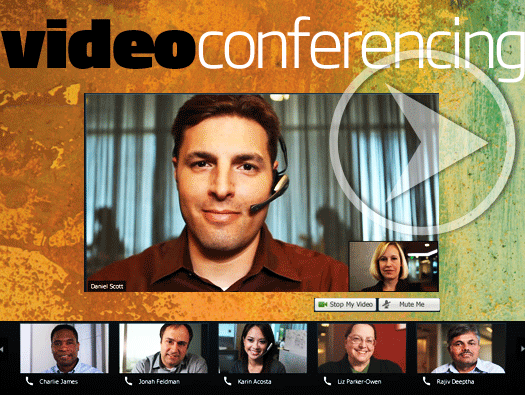-
Videoconferencing Continues to Evolve
Videoconferencing and telepresence have come a long way in the last few years. Skype brought most consumers to video conferencing with its free, easy-to-use video chat service. In the enterprise, employees communicate with far-flung colleagues using robust products from the likes of Cisco and Microsoft. Videoconferencing is now common on tablets and smartphones with Apple Facetime and other mobile video call apps. But that’s just the beginning: Videoconferencing has also extended to boardroom style video calls connecting large groups, remote doctor-patient care, virtual field trips for students and even 3D holograms.
By Shane O’Neill, CIO.com

-
Skype Brings Video Chat to the Mainstream
For most people, it all began with Skype. The popular service, acquired by Microsoft in May 2011 for $8.5 billion, combines voice, video and instant messaging communication over the Internet. The user-friendly Skype — it reached verb status: “Let’s Skype” — made video chatting safe for technophobe grandfathers everywhere and has expanded to mobile apps for use on smartphones and tablets. As of September 2011, Skype had 663 million registered users. Other consumer videoconferencing services include iChat for Mac users, Google Hangouts (via Google+), and newer entries SightSpeed, ooVoo and Tokbox.

-
The Enterprise Talking Heads
Enterprise-level videoconferencing has exploded in recent years as a way for far-flung work groups to see each other regularly. This space is led by big names such as Cisco, Citrix, Adobe and Microsoft. Obviously these platforms are more feature-rich than consumer services and they are definitely not free. But in return you get high-definition video and enterprise security features such as VPN (virtual private network) functionality that keeps videoconferencing sessions safe behind the corporate firewall.

-
Videoconferencing Goes Mobile
Videoconferencing is by no means limited to your desk or couch. As consumers and businesses shift computing needs from PCs to smartphones and tablets, videoconferencing made the migration to handhelds. For one-to-one chatting, Apple’s proprietary video chat app, Facetime, is popular among iPhone and iPad users, and Skype rolled out an app for all major mobile platforms last year. Google Hangouts are accessible on Android and other platforms as are many other consumer videoconferencing services. Enterprise videoconferencing platforms like Microsoft Lync, Cisco Jabber and Citrix GoToMeeting have also delivered mobile versions for Android and iOS devices.

-
The Product Launch Surprise Guest
More and more, videoconferencing is being used to wow the crowd at an event with a surprise guest. At the launch of Microsoft Lync in November 2010, Microsoft co-founder Bill Gates popped up on a videoconferencing session using — what else — Lync’s video call feature. Surprise!

-
Your Doctor is on Call, Video Call
After all the discussion about videoconferencing vendors and devices, the technology really can unite people and solve problems. A fine example: Remote doctor-patient communication. Patients in areas with scarce medical resources can receive treatment and consultations through videoconferencing. Pictured here is Cisco’s VX Clinical Assistant, a “telemedicine” cart on wheels that provides HD video collaboration so doctors can examine patients from anywhere in the world. Also, a doctor physically present with a patient can bring in another doctor for a second opinion via videoconferencing.

-
3D Holograms – Be There Without Being There
No this is not science fiction. At a recent Cisco event in India, Cisco CEO John Chambers asked Cisco executives Martin De Beer and Chuck Stucki to join him onstage. But instead of entering from stage right, they beamed in via 3D holographic images. The surprise holograms were a collaboration project where Cisco integrated its TelePresence technology with Musion Systems’ 3D holographic display technology. Has a nice Star Trek vibe, no?

-
3D Holograms – Back from the Dead
The use of holograms also reached a pop culture zenith at the Coachella Music Festival in California last April when a holographic image of the late rapper Tupac Shakur made an appearance on stage with fellow rapper Snoop Dogg.

-
Dance is their Calling
If your company can afford it, a Cisco TelePresence room provides HD 1080p video, spatial audio, and a setup designed to link two physically separated rooms so they resemble a single conference room. This could replicate a huge executive boardroom or, much more fun, a dance recital. Pictured here is Jacques d’Amboise, founder of the National Dance Institute, and his dancers in Cisco’s New York office. Dancers from Shanghai Children’s Palace on the screen are across the world in the Cisco Pavilion at World Expo 2010 in Shanghai. The two groups used Cisco TelePresence to hold a virtual dance rehearsal before they met face-to-face.

-
Virtual Field Trips for the Kids
Virtual field trips are a new trend for students to learn and interact. Students are given an all access pass, able to visit historic landmarks such as the Museum of Television and Radio or the NASA Glenn Research Center without leaving the classroom. Teachers can use virtual field trips to supplement curriculum and bring in specialized experts. This photo of a virtual field trip was provided by Core BTS, a solution provider that helps implement videoconferencing products from Cisco, Microsoft, Citrix and others.

-
Video Calls from the (Battle) Field
Military personnel use videoconferencing and telepresence to connect via satellite in some of the most remote locations such as in a tank roaming the desert. Using Cisco TelePresence VX Tactical, a mobile telepresence product that includes Cisco’s codec technology in a portable, briefcase-style form factor, these soldiers are able to securely provide information, discuss strategy and visually show surroundings to headquarters thousands of miles away.
















